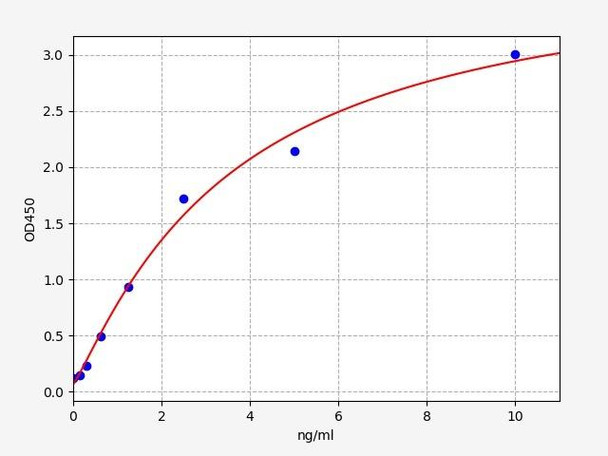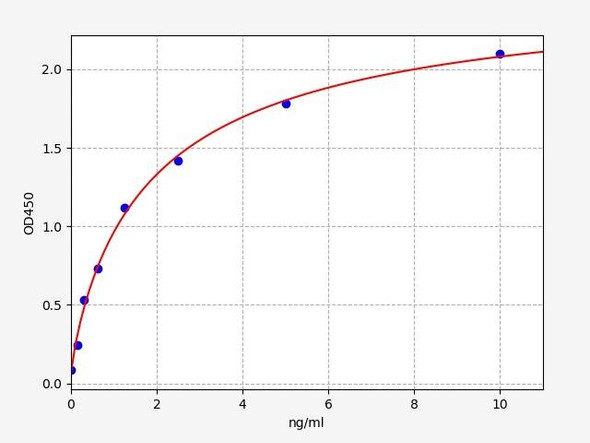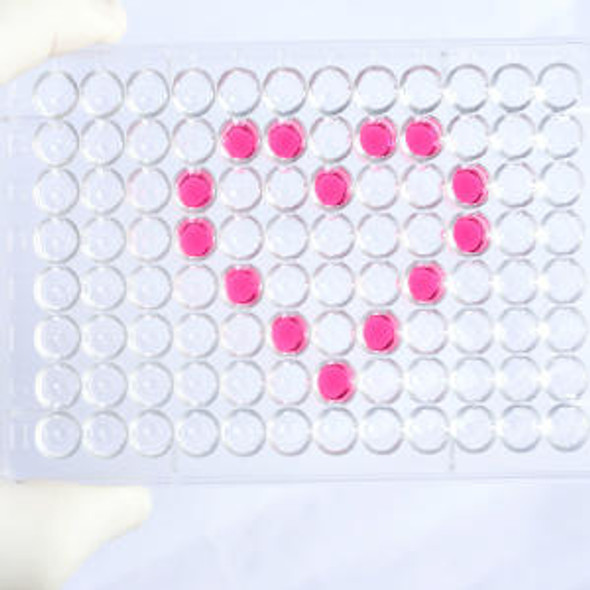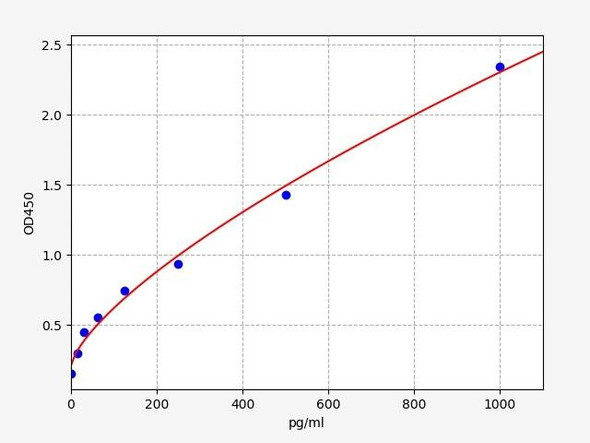Human CAMK2D(CaMKII delta) ELISA Kit
- SKU:
- HUFI03354
- Product Type:
- ELISA Kit
- Size:
- 96 Assays
- Uniprot:
- Q13557
- Sensitivity:
- 0.094ng/ml
- Range:
- 0.156-10ng/ml
- ELISA Type:
- Sandwich ELISA, Double Antibody
- Synonyms:
- CaM kinase II subunit delta, CaMK II subunit delta, CAMK2D, CAMKD
- Reactivity:
- Human
Description
| Product Name: | Human CAMK2D(CaMKII delta) ELISA Kit |
| Product Code: | HUFI03354 |
| Size: | 96 Assays |
| Alias: | CaM kinase II subunit delta, CaMK II subunit delta, CAMK2D, CAMKD |
| Detection method: | Sandwich ELISA, Double Antibody |
| Application: | This immunoassay kit allows for the in vitro quantitative determination of Human CAMK2D concentrations in serum plasma and other biological fluids. |
| Sensitivity: | 0.094ng/ml |
| Range: | 0.156-10ng/ml |
| Storage: | 4°C for 6 months |
| Note: | For Research Use Only |
| Recovery: | Matrices listed below were spiked with certain level of Human CAMK2D and the recovery rates were calculated by comparing the measured value to the expected amount of Human CAMK2D in samples. Enquire for more information. |
| Linearity: | The linearity of the kit was assayed by testing samples spiked with appropriate concentration of Human CAMK2D and their serial dilutions. The results were demonstrated by the percentage of calculated concentration to the expected. Enquire for more information. |
| CV(%): | Intra-Assay: CV<8% Inter-Assay: CV<10% |
| Component | Quantity | Storage |
| ELISA Microplate (Dismountable) | 8×12 strips | 4°C for 6 months |
| Lyophilized Standard | 2 | 4°C/-20°C |
| Sample/Standard Dilution Buffer | 20ml | 4°C |
| Biotin-labeled Antibody(Concentrated) | 120ul | 4°C (Protect from light) |
| Antibody Dilution Buffer | 10ml | 4°C |
| HRP-Streptavidin Conjugate(SABC) | 120ul | 4°C (Protect from light) |
| SABC Dilution Buffer | 10ml | 4°C |
| TMB Substrate | 10ml | 4°C (Protect from light) |
| Stop Solution | 10ml | 4°C |
| Wash Buffer(25X) | 30ml | 4°C |
| Plate Sealer | 5 | - |
Other materials and equipment required:
- Microplate reader with 450 nm wavelength filter
- Multichannel Pipette, Pipette, microcentrifuge tubes and disposable pipette tips
- Incubator
- Deionized or distilled water
- Absorbent paper
- Buffer resevoir
| Uniprot | Q13557 |
| UniProt Protein Function: | CAMK2D: a protein kinase of the calcium/calmodulin-dependent protein kinase (CAMK) group that interacts with the sarcoplasmic reticulum membrane in cardiac and skeletal muscle. Regulates Ca2+ homeostatis and excitation-contraction coupling (ECC) in heart. Calmodulin binding induces conformational changes that relieve autoinhibition, permitting autophosphorylation at T287, rendering the kinase constitutively active and independent of Ca2+-binding. Targets ion channels, transporters and accessory proteins involved in Ca2+ influx into the myocyte, Ca2+ release from the sarcoplasmic reticulum (SR), SR Ca2+ uptake and Na+ and K+ channel transport. Also targets transcription factors and signaling molecules to regulate heart function. In its activated form, is involved in the pathogenesis of dilated cardiomyopathy and heart failure. Contributes to cardiac decompensation and heart failure by regulating SR Ca2+ release via direct phosphorylation of RYR2 Ca2+ channel on S2808. In the nucleus, phosphorylates the MEF2 repressor HDAC4, promoting its nuclear export and binding to 14-3-3 protein, and expression of MEF2 and genes involved in the hypertrophic program. Is essential for left ventricular remodeling responses to myocardial infarction. In pathological myocardial remodeling acts downstream of the beta adrenergic receptor signaling cascade to regulate key proteins involved in ECC. Regulates Ca2+ influx to myocytes by binding and phosphorylating the L-type Ca2+ channel subunit beta-2 CACNB2. In addition to Ca2+ channels, can target and regulate the cardiac sarcolemmal Na+ channel SCN5A and the K+ channel Kv4.3, which contribute to arrhythmogenesis in heart failure. Phosphorylates phospholamban (PLB), an endogenous inhibitor of SERCA2A, contributing to the enhancement of SR Ca2+ uptake that may be important in frequency-dependent acceleration of relaxation (FDAR) and maintenance of contractile function during acidosis. May participate in the modulation of skeletal muscle function in response to exercise, by regulating SR Ca2+ transport through phosphorylation of PLB and TRDN, a ryanodine receptor-coupling factor. CAMK2 is composed of 4 different chains: alpha (CAMK2A), beta (CAMK2B), gamma (CAMK2G), and delta (CAMK2D). The different isoforms assemble into homo- or heteromultimeric holoenzymes composed of 12 subunits with two hexameric rings stacked one on top of the other. Interacts with RRAD and CACNB2. Ten isoforms of the human protein are produced by alternative splicing. Isoform Delta3, isoform Delta2, isoform Delta8 and isoform Delta9 are expressed in cardiac muscle. Isoform Delta11 is expressed in skeletal muscle. Activity is induced in skeletal muscle during exercise. The CAMK2 protein kinases contain a unique C-terminal subunit association domain responsible for oligomerization. |
| UniProt Protein Details: | Protein type:EC 2.7.11.17; Kinase, protein; Protein kinase, CAMK; Protein kinase, Ser/Thr (non-receptor); CAMK group; CAMK2 family Chromosomal Location of Human Ortholog: 4q26 Cellular Component: nucleoplasm; sarcoplasmic reticulum membrane; membrane; perinuclear region of cytoplasm; cytoplasm; plasma membrane; nucleus; cytosol; sarcolemma Molecular Function:calmodulin binding; sodium channel inhibitor activity; protein serine/threonine kinase activity; protein binding; protein homodimerization activity; calmodulin-dependent protein kinase activity; titin binding; nitric-oxide synthase binding; ATP binding Biological Process: positive regulation of smooth muscle cell proliferation; protein amino acid autophosphorylation; cytokine and chemokine mediated signaling pathway; peptidyl-threonine phosphorylation; positive regulation of smooth muscle cell migration; protein amino acid phosphorylation; cellular potassium ion homeostasis; regulation of heart contraction; protein oligomerization; regulation of transcription from RNA polymerase II promoter; positive regulation of Rac protein signal transduction; synaptic transmission; endoplasmic reticulum calcium ion homeostasis; peptidyl-serine phosphorylation; regulation of G2/M transition of mitotic cell cycle; response to hypoxia; regulation of cell growth; regulation of the force of heart contraction |
| NCBI Summary: | The product of this gene belongs to the serine/threonine protein kinase family and to the Ca(2+)/calmodulin-dependent protein kinase subfamily. Calcium signaling is crucial for several aspects of plasticity at glutamatergic synapses. In mammalian cells, the enzyme is composed of four different chains: alpha, beta, gamma, and delta. The product of this gene is a delta chain. Alternative splicing results in multiple transcript variants encoding distinct isoforms. Distinct isoforms of this chain have different expression patterns.[provided by RefSeq, Nov 2008] |
| UniProt Code: | Q13557 |
| NCBI GenInfo Identifier: | 116242602 |
| NCBI Gene ID: | 817 |
| NCBI Accession: | Q13557.3 |
| UniProt Secondary Accession: | Q13557,Q52PK4, Q59G21, Q8N553, Q9UGH6, Q9UQE9, A8MVS8 |
| UniProt Related Accession: | Q13557 |
| Molecular Weight: | 499 |
| NCBI Full Name: | Calcium/calmodulin-dependent protein kinase type II subunit delta |
| NCBI Synonym Full Names: | calcium/calmodulin-dependent protein kinase II delta |
| NCBI Official Symbol: | CAMK2DÂ Â |
| NCBI Official Synonym Symbols: | CAMKDÂ Â |
| NCBI Protein Information: | calcium/calmodulin-dependent protein kinase type II subunit delta; CaMK-II delta subunit; caMK-II subunit delta; CaM-kinase II delta chain; CaM kinase II delta subunit; caM kinase II subunit delta; calcium/calmodulin-dependent protein kinase type II delta |
| UniProt Protein Name: | Calcium/calmodulin-dependent protein kinase type II subunit delta |
| Protein Family: | Calcium/calmodulin-dependent protein kinase |
| UniProt Gene Name: | CAMK2DÂ Â |
| UniProt Entry Name: | KCC2D_HUMAN |
*Note: Protocols are specific to each batch/lot. For the correct instructions please follow the protocol included in your kit.
Before adding to wells, equilibrate the SABC working solution and TMB substrate for at least 30 min at 37°C. When diluting samples and reagents, they must be mixed completely and evenly. It is recommended to plot a standard curve for each test.
| Step | Protocol |
| 1. | Set standard, test sample and control (zero) wells on the pre-coated plate respectively, and then, record their positions. It is recommended to measure each standard and sample in duplicate. Wash plate 2 times before adding standard, sample and control (zero) wells! |
| 2. | Aliquot 0.1ml standard solutions into the standard wells. |
| 3. | Add 0.1 ml of Sample / Standard dilution buffer into the control (zero) well. |
| 4. | Add 0.1 ml of properly diluted sample ( Human serum, plasma, tissue homogenates and other biological fluids.) into test sample wells. |
| 5. | Seal the plate with a cover and incubate at 37 °C for 90 min. |
| 6. | Remove the cover and discard the plate content, clap the plate on the absorbent filter papers or other absorbent material. Do NOT let the wells completely dry at any time. Wash plate X2. |
| 7. | Add 0.1 ml of Biotin- detection antibody working solution into the above wells (standard, test sample & zero wells). Add the solution at the bottom of each well without touching the side wall. |
| 8. | Seal the plate with a cover and incubate at 37°C for 60 min. |
| 9. | Remove the cover, and wash plate 3 times with Wash buffer. Let wash buffer rest in wells for 1 min between each wash. |
| 10. | Add 0.1 ml of SABC working solution into each well, cover the plate and incubate at 37°C for 30 min. |
| 11. | Remove the cover and wash plate 5 times with Wash buffer, and each time let the wash buffer stay in the wells for 1-2 min. |
| 12. | Add 90 µl of TMB substrate into each well, cover the plate and incubate at 37°C in dark within 10-20 min. (Note: This incubation time is for reference use only, the optimal time should be determined by end user.) And the shades of blue can be seen in the first 3-4 wells (with most concentrated standard solutions), the other wells show no obvious color. |
| 13. | Add 50 µl of Stop solution into each well and mix thoroughly. The color changes into yellow immediately. |
| 14. | Read the O.D. absorbance at 450 nm in a microplate reader immediately after adding the stop solution. |
When carrying out an ELISA assay it is important to prepare your samples in order to achieve the best possible results. Below we have a list of procedures for the preparation of samples for different sample types.
| Sample Type | Protocol |
| Serum | If using serum separator tubes, allow samples to clot for 30 minutes at room temperature. Centrifuge for 10 minutes at 1,000x g. Collect the serum fraction and assay promptly or aliquot and store the samples at -80°C. Avoid multiple freeze-thaw cycles. If serum separator tubes are not being used, allow samples to clot overnight at 2-8°C. Centrifuge for 10 minutes at 1,000x g. Remove serum and assay promptly or aliquot and store the samples at -80°C. Avoid multiple freeze-thaw cycles. |
| Plasma | Collect plasma using EDTA or heparin as an anticoagulant. Centrifuge samples at 4°C for 15 mins at 1000 × g within 30 mins of collection. Collect the plasma fraction and assay promptly or aliquot and store the samples at -80°C. Avoid multiple freeze-thaw cycles. Note: Over haemolysed samples are not suitable for use with this kit. |
| Urine & Cerebrospinal Fluid | Collect the urine (mid-stream) in a sterile container, centrifuge for 20 mins at 2000-3000 rpm. Remove supernatant and assay immediately. If any precipitation is detected, repeat the centrifugation step. A similar protocol can be used for cerebrospinal fluid. |
| Cell culture supernatant | Collect the cell culture media by pipette, followed by centrifugation at 4°C for 20 mins at 1500 rpm. Collect the clear supernatant and assay immediately. |
| Cell lysates | Solubilize cells in lysis buffer and allow to sit on ice for 30 minutes. Centrifuge tubes at 14,000 x g for 5 minutes to remove insoluble material. Aliquot the supernatant into a new tube and discard the remaining whole cell extract. Quantify total protein concentration using a total protein assay. Assay immediately or aliquot and store at ≤ -20 °C. |
| Tissue homogenates | The preparation of tissue homogenates will vary depending upon tissue type. Rinse tissue with 1X PBS to remove excess blood & homogenize in 20ml of 1X PBS (including protease inhibitors) and store overnight at ≤ -20°C. Two freeze-thaw cycles are required to break the cell membranes. To further disrupt the cell membranes you can sonicate the samples. Centrifuge homogenates for 5 mins at 5000xg. Remove the supernatant and assay immediately or aliquot and store at -20°C or -80°C. |
| Tissue lysates | Rinse tissue with PBS, cut into 1-2 mm pieces, and homogenize with a tissue homogenizer in PBS. Add an equal volume of RIPA buffer containing protease inhibitors and lyse tissues at room temperature for 30 minutes with gentle agitation. Centrifuge to remove debris. Quantify total protein concentration using a total protein assay. Assay immediately or aliquot and store at ≤ -20 °C. |
| Breast Milk | Collect milk samples and centrifuge at 10,000 x g for 60 min at 4°C. Aliquot the supernatant and assay. For long term use, store samples at -80°C. Minimize freeze/thaw cycles. |










